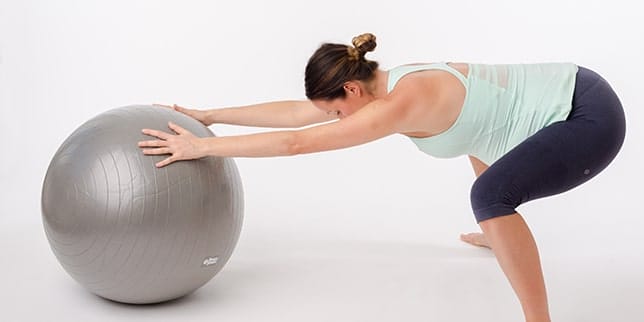Pilates Moves To Prep Your Body For Childbirth

Six Pilates exercises that will help you get ready for delivery.
As you enter your third trimester, it’s time to begin thinking about the big day and how to best prepare your body for the challenges of childbirth. You will require physical stamina, muscle endurance, strength and whole lot of mind control. Pilates is a safe and effective form of exercise you can do all the way up to the day you give birth. Here are the top Pilates moves I recommend you include in your workouts as you approach your due date.

Squats
Squatting is an awesome way to strengthen the lower body to support the pelvis. If you do plan on natural childbirth, having strong legs will be crucial to ensure you can hold some of the recommended birthing positions.
EXERCISE
Inhale – through your nose and sit back into the squat.
Exhale – out your mouth, pull your belly button into your spine, keep this connection & stand up.
REPS – 3 sets of 8
Challenge – Hold the squat between each set for 8 breaths. This is great practice for the mental toughness and breath control you will need for labor. This skill can be used during a contraction.


Clamshell
Clamshell is an oldy but a goody to strengthen the deep muscles of butt called the external rotators. Clamshell, in fact, exactly mimics one of the Bradley Method birthing poses (a well known natural birthing guide) called the Side Pushing Position.
Set-up – Side-lying with knees bent. Pelvis & spine are in neutral with hips & knees stacked.
EXERCISE
INHALE – through your nose to prepare.
EXHALE – out your mouth, first hugging your baby into your spine to engage your deep core the begin to open the top leg up but keep the heels of the feet squeezing together.
Reps – x 20 each leg


Plies – practicing the Reverse Breathing technique
Plies are one of my favorite third trimester exercises and a great way move to work on your Reverse Breathing technique. Reverse breathing is an important skill to learn as you approach the birth. This is the breath pattern you will use in the pushing phase of labor. It’s important to master this skill and be able to harness the power of your exhale to fully release the pelvic floor so the baby can come out.
SET-UP – Standing with legs wide apart and your feet externally rotated.
EXERCISE
Inhale – Through your nose
Exhale – out your mouth and bend your knees, lowering straight down into a plié. Focus on a full release of your pelvic floor as you lower down
Inhale again – through your nose & lift the pelvic floor, hug your baby to your spine and stand back up
REPS – 3 sets of 8
Challenge – Hold the plie in between each set and practice the reverse breathing technique whilst your pelvic floor is stretched out–8 breaths for each hold.



Pelvic Floor Stretching
The Pelvic Floor muscles (PFM) are really an incredible system that needs lots of TLC. As you approach your due date you need to begin to include daily stretching of the PFM so they can fully release to enable the baby to come out.
SET-UP– Place a yoga block or stack of pillows against the wall. Stand with your back to the wall with your feet out in front of you.
INHALE – through your nose as you begin to slowly slide down the wall.
EXHALE – out your mouth as you continue down the wall allowing your pelvic floor to fully release.
Keep going down and keep feeling the pelvic floor stretch until you reach the yoga block/pillows. Once you are down, slowly butterfly the knees open and gently apply pressure just above the knees to get an additional stretch. Hold the stretch for 90 secs. Close the knees and then repeat again.
REPS – 3 x Daily
TIP – Never hold a stretch too long – max 30-40 sec. You can always repeat the stretch. Due to the hormone relaxin loosening the ligaments & relaxing muscles, you want to be careful that you don’t go too far in a stretch and damage joints.


TVA Counting
During your pregnancy, the foundation of all your prenatal workouts should be deep core breathing exercises. One of the main deep core muscles is the TVA – it wraps around the midsection of the body like a pair of Spanx. When activated correctly it cinches, lengthens and importantly during childbirth, it compresses. During the pushing phase of labor, “TVA Counting” engages the TVA, helping the uterus in the final contractions to get your baby out. The longer you can maintain the activation, the more assistance it is giving the uterus!
SET-UP – Seated in neutral spine and pelvis on a physioball, yoga block or bolster, a household chair.
EXERCISE
INHALE – through your nose and allow your belly to fill up with air and muscles relax.
EXHALE– out your mouth and image pulling your belly button all the way to your spine, the TVA wrapping around your midsection – cinching and lengthening. Hold that connection and begin to count out loud. Make sure to take small sips of air as you count. The goal is to be able to maintain the connection whilst breathing.
REPS – Start out by counting to 10 and build to 25. 10 sets of 10 or 4 sets of 25
Challenge – do the exercise in the All-Fours position with gravity working against you – all fours is another Bradley Method suggested birthing position to try!



Standing Swan
If you don’t have a physioball, and if you have the space for it – get one! It is such an awesome prop for any pregnant women and can be a wonderful tool for labor. The Standing Swan combines core strength, lower body endurance, spinal mobility, pelvic floor stretching and gives you the opportunity to practice the Reverse Breathing technique. It’s kinda the mac daddy of labor preparation exercises.
Set-up – Standing legs apart and externally rotated with the physioball just in front of your legs.
EXERCISE
INHALE – through your nose, nod your chin and begin to roll-down. As you do, place your hands on the ball and start to push the ball out in front of you.
EXHALE – out your mouth as you continue to push the ball, folding at the hips, bending the knees and reaching your sits bones out behind you until your arms are straight and body is almost parallel to the mat.
INHALE – through your nose, hold the position
EXHALE – out your mouth as you hug your baby to your spine, lift your pelvic floor, rounding your low back into a c curve and slowly stand back up.
TIP – When you are down in the swan position – practice your reverse breathing for 5 breaths. This will challenge your legs and also stretch your pelvic floor.


































